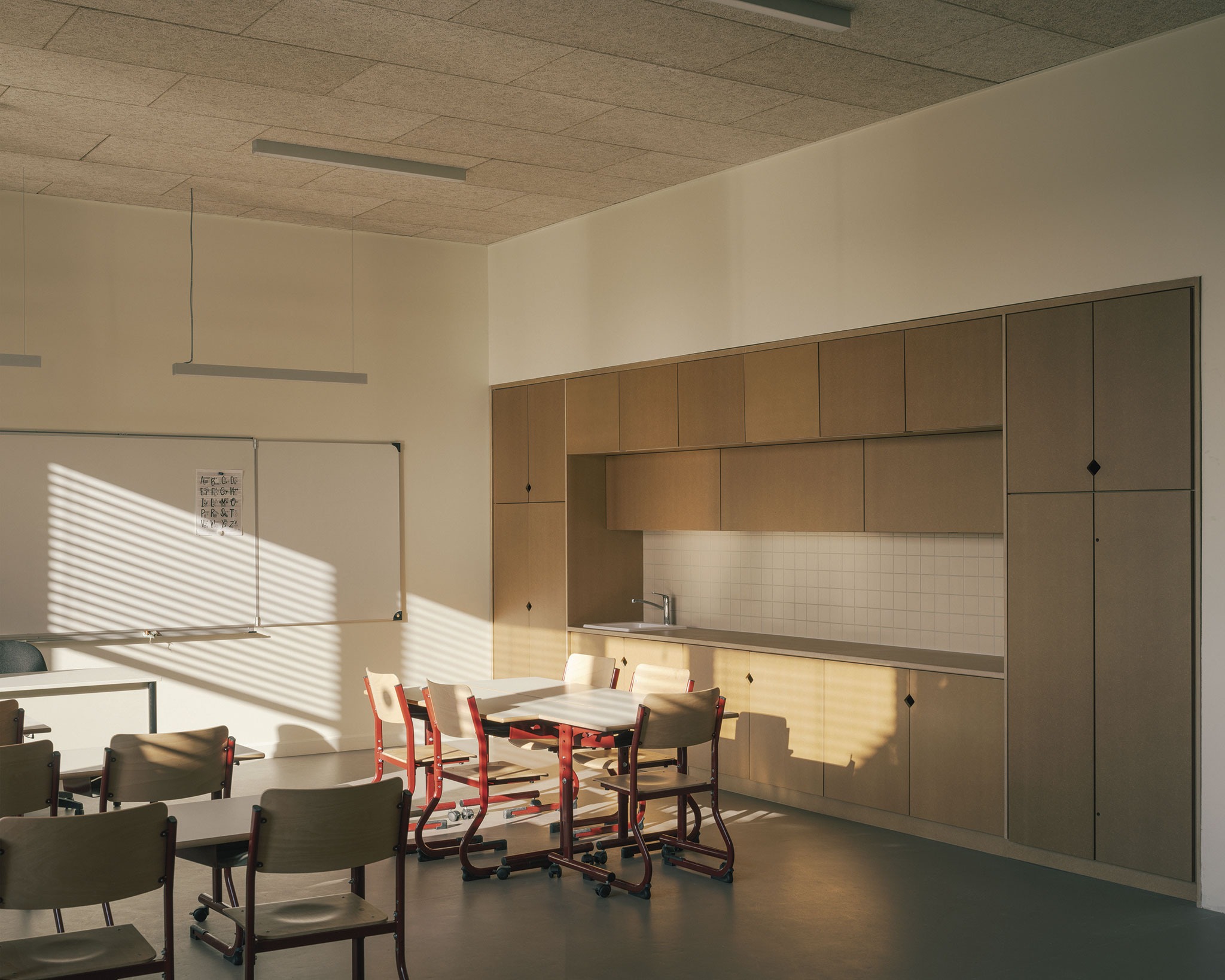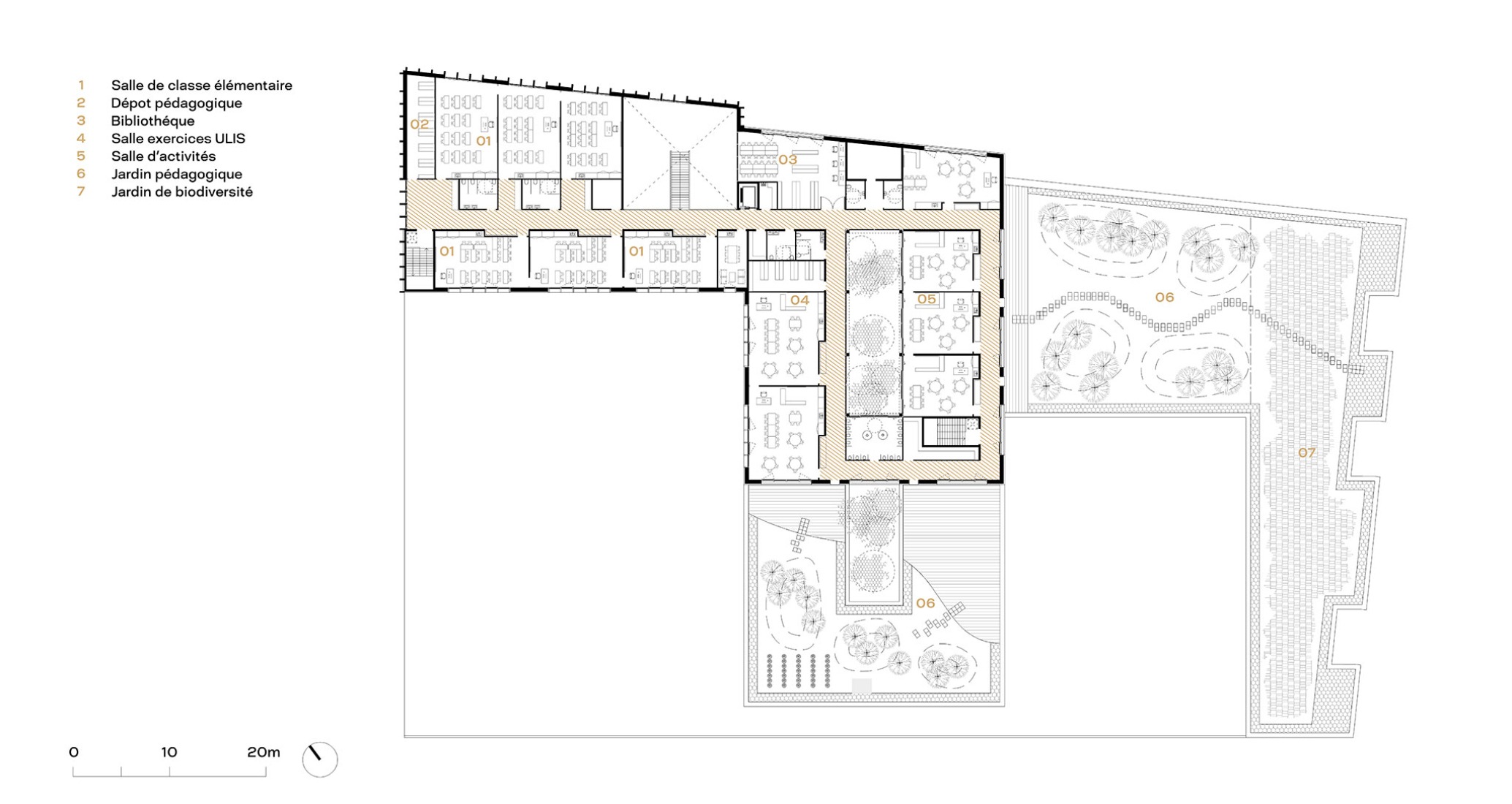
Developed from a series of different volumes with three distinct programmatic entities, the educational centre developed by Vallet de Martinis Architectes, allows, through a homogeneous language, that the “Claudie Haigneré” School Group is understood as a whole and despite its large surface area, manages to create a unique universe in which children can feel a sense of belonging in the place and make it their own.
The complex orients the spaces, their thickness and dimensioning in such a way that it develops perspectives towards the surrounding landscape, serving as a transition between the city and the intimacy of the school. It also creates welcoming spaces based on a structural framework laid out by the different materials that compose it, such as terracotta bricks, concrete or large wooden glass frames, which allow visitors to benefit from easy and optimal circulation with a large presence of plants and atmospheres of tranquility achieved thanks to the correct treatment of light and colour inside.

"Claudie Haigneré" School Group by Vallet de Martinis Architectes. Photograph by Charly Broyez.
Project description by Vallet de Martinis Architectes
The school group of the ZAC Clause Bois Badeau is part of a vast operation to enhance the agro-industrial wasteland located to the west of the Brétigny-sur-Orge train station, whose first residents began to settle in 2012.
The project includes a nursery school, an elementary school, a catering center and a leisure center without accommodation (ALSH). Like a puzzle piece, it fits into a plot surrounded by the Joncs Marins, the Jardin de Traverse, a network of small houses and some collective housing operations.
The school group benefits from very good urban visibility. Its three main facades are oriented towards significant spaces:
· The forecourt overlooks Avenue Jacqueline de Romilly and is the main entrance to the building. The structural framework is highlighted on this main façade, as well as on Rue des Cendrennes or on Jardin de Traverse, in order to give an overall homogeneity to the school group.
· The south of the plot overlooks Jardin de Traverse, designated as the "schoolchildren's path" of the urban project. This pedestrian and cycle path irrigates the entire district in depth. It offers the possibility of hosting children's games, educational gardens or even vegetable gardens.
· To the north of the plot is Rue des Cendrennes, which marks the boundary between the urbanization of the Orge valley and Joncs Marins. This small street constitutes the secondary access to the school group: staff parking, delivery area and access to the multipurpose room positioned at the corner of Avenue de Romilly. For this façade, the elementary courtyard is oriented towards the forest and the vast landscape, bringing calm and serenity.

Institutional affirmation and the intimacy of uses are essential to the identification of the project. Without knowing what is happening inside, this place is identifiable as a public institution.
The work done on the volumes and facades highlights the school group within a fabric mainly composed of individual houses and collective housing. The entrances are mainly defined on the Avenue de Romilly which is directly linked to the forecourt, an interface between the city and the school. From the avenue, the entrances are distinguishable by a play of hollows and a concrete materiality.
Discretion is also required in a school group. The orientation of the built spaces, their thickness and dimensioning as well as the spacing of the wooden posts on the facade make it a discreet space for its users. It is not possible to clearly distinguish the uses linked to the school group from the outside. The interior spaces are mainly turned inwards, allowing the classrooms to be at a distance from direct contact with the public space.
Transversalities are created on the site through the layout of voids (courtyards) and solids (learning and activity spaces). The layout of the courtyards provides transversalities towards the built environment or nature. The cloister model for the nursery school benefits from transversalities towards the built environment, while the “L” model for the elementary school benefits from transversalities towards nature. These transversalities provide children with peaceful spaces and great ease of orientation within the schools. The project thus finds its balance between the centrality of the courtyard, characteristic of the institution’s introversion, and a necessary openness to the outside.

The project also aims to develop perspectives towards the surrounding landscape. The Jardin de Traverse and the Joncs Marins are the two privileged views of the building. Since children spend more time in the classrooms than in the courtyard, the exercise rooms of the two schools are turned towards the outside: the Jardin de Traverse for the nursery school; the Sea Rushes and the forest for the elementary school.
Architectural bias
The forecourt is imagined as a large transition space between the city and the intimacy of the school. The use of the concrete floor, as well as the foundations, contribute to the affirmation of the scale and institutional status of the school group. The three hollow entrances on the facade rue de Romilly, make it possible to offer a simple reading of the entire building and orientation in the establishment.
The children of the nursery school access the hall directly facing the courtyard, the children who go to after-school care access the hall facing the first patio and the pupils of the elementary school access the third majestic hall in double height including a monumental straight wooden staircase. This hall is directly linked to the courtyard and the multipurpose room.

The three volumes constitute the conceptual order of the project: three programmatic entities for three architectural volumes. The city's residents must be able to distinguish the school group as being the meeting of three different entities within the same place. The different levels of the building follow the child's school career, from kindergarten on the ground floor to CM2 on the first floor.
The nursery school and the elementary school are clearly distinguished in plan, but also in the facade. The nursery school is only deployed on the ground floor, with the exception of two buffer classes placed on R+1. The elementary school is arranged on two levels: on the ground floor for the common areas and on R+1 for all the classrooms and adult premises. The nursery school is positioned to the south of the plot, while the elementary school is arranged to the north. The common areas such as all the ALHS premises, the common area and the catering are located in the center of the two schools.
Homogeneity within the project is also a key concept, allowing it to be understood as the Clause Bois Badeau school group as a whole. This is achieved by asserting the structure of the building on the facade and using the same materials: wooden posts on concrete bases, interstices in terracotta brick and large wooden glazed frames. A structural framework is therefore developed throughout the project.

Treatment of light and materials
The treatment of natural light shapes the space. The orientations and openings make it possible to obtain different treatments of natural light depending on the spaces, while ensuring a generous solar contribution.
The circulations of the nursery school, thanks to a cloister organization of the courtyard, benefit from optimal sunshine throughout the day. Those of the after-school care center have large bay windows overlooking the patios and large glass frames with moucharabieh on the upper floor. Finally, for the only circulation that serves all the elementary classrooms, the thickness of the frame makes it possible to arrange the classrooms on either side of the circulation while opening the end widely onto the Seagrass. The transparencies at all points of the school allow for a fairly global perception of the environment. Through the courtyards, patios and terraces, vegetation asserts its presence and contributes to the general well-being.
Interior spaces
Interior spaces are primarily aimed at children. The school seeks to create a unique universe in which children can identify with the place and make it their own. The first vector of identification is signage. It is both fun, by integrating easily identifiable logos and at the same time didactic. All toilets, shower rooms and dining rooms are adapted to the height of children. The colors and shapes are adapted to the collective imagination of children.
If children recognize themselves in the treatment of certain spaces, they must also be able to leave their mark on them. Display areas dedicated to children's interventions are thus provided within the building. Storage spaces under the benches and coat hooks are, with the school tables, spaces that children can invest with their personal belongings.

Outdoor spaces
Each hall of the school group is directly connected to an outdoor space: the schools are oriented towards the classes, while the after-school care opens onto the patios. The playground of the nursery schools in the cloister allows the pupils to detach themselves from the city, while the playground of the elementary school is oriented towards the forest and the refectory. This creates a link with the great landscape of the Joncs Marins and easy access to the refectory.
The large roof surfaces are planted in different ways. The roofs of the ground floor accommodate the educational gardens, the ornamental gardens but also a vegetable garden and a nursery. The children are therefore detached from the ground floor to turn towards the sky.
As for the after-school care, a first large patio of approximately 110m² provides soft light and interactions between the children in the heart of the activity rooms on two levels. A second 70m² patio allows the elementary refectory to be entirely oriented towards an abundantly planted exterior. The rest room of the ALSH maternal is positioned between these two patios in order to offer it a double orientation inspiring appeasement.



















































